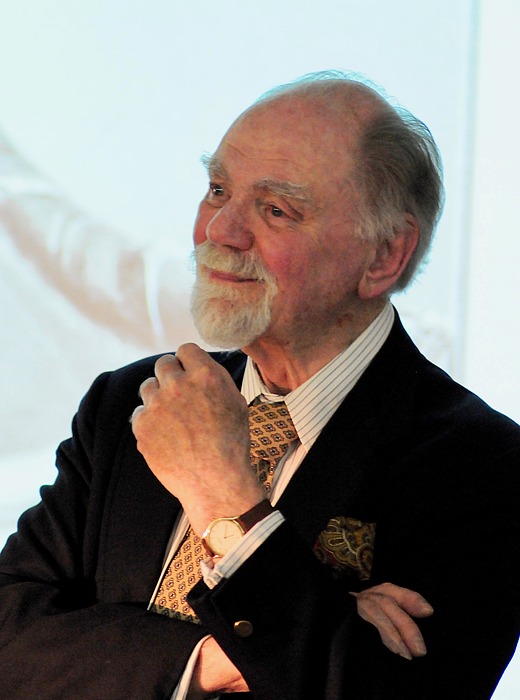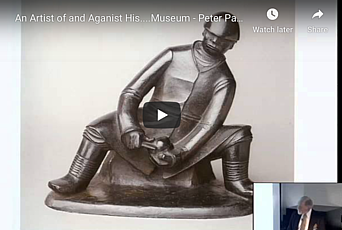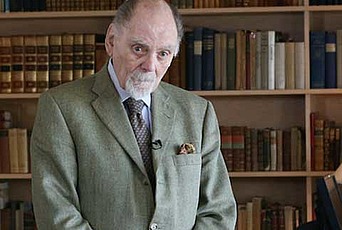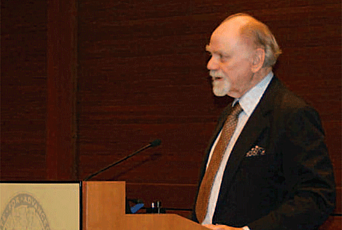Peter Paret (1924–2020), Military Historian and Intellectual Beacon, Dies at 96
Press Contact

Peter Paret, Professor Emeritus in the School of Historical Studies at the Institute for Advanced Study, passed away peacefully at age 96 at his Salt Lake City home on September 11, 2020. A German-born American and acclaimed cultural and intellectual historian, Paret studied the modern historiography of war from 18th- to 20th-century Europe, as well as the relationship of art, society, and politics.
Paret first joined the Institute’s School of Historical Studies as a Member for the 1966–67 academic year and returned in 1986 to become the Andrew W. Mellon Professor in the Humanities. Paret became a Professor Emeritus in 1997 and remained active and productive through his retirement.
“The combination of engagement and detachment with which Peter approached historical questions, and the shrewdness and energy with which he always argued his case, made him a vigorous contributor to intellectual life at the Institute, and cemented his legacy as one of the leading historians of the 20th century,” stated Robbert Dijkgraaf, IAS Director and Leon Levy Professor. “His legacy as an educator, author, and innovator will continue to inform the field for generations to come.”
Paret was born in Berlin on April 13, 1924, the son of Hans Paret and Suzanne Aimée Cassirer. His mother’s father, Paul Cassirer, was a publisher and art dealer and an important force for modernism in the arts in Germany. His mother’s uncle was the philosopher Ernst Cassirer. Following his parents’ divorce, Paret joined his mother and sister living in Vienna in 1933. His mother remarried psychoanalyst and educational reformer Siegfried Bernfeld the following year, and with her husband and children moved to France. In 1937, they emigrated to the United States, settling in San Francisco.
Paret enrolled at the University of California, Berkeley in 1942. He was drafted for World War II the following year and served in combat intelligence and operations sections of an infantry battalion in the New Guinea and Philippines campaigns and in Korea. He was discharged in 1946 with the rank of Staff Sergeant, reentered Berkeley as a sophomore, and graduated in 1949. In 1956, Paret began his graduate studies in history at King’s College, University of London, completing his dissertation on the Prussian Reform era under Sir Michael Eliot Howard and graduating with a Ph.D. in 1960.
Paret published his first book, Guerrillas in the 1960s (Praeger, 1961) with John W. Shy on contemporary military theory, while working as Research Associate at the Center of International Studies at Princeton University (1960–1962). In it, he argues that “Basically, the problem [of guerrilla warfare] is political; to attempt to understand it as a purely military one is the most dangerous kind of oversimplification. Guerrillas are a symptom rather than a cause. Lasting success requires a viable political settlement, and even operational success over a period of time demands the proper political framework for effective military action.” Throughout his career Paret eagerly looked beyond the pure military narrative, expanding the study of conflict into the greater context of society. He saw subjects as seemingly diverse as the military, politics, culture, and the arts as all interconnected.
“Peter Paret was an historian of modern Europe who began as an authority on war and on Clausewitz in particular, but his interests and competence ranged far beyond that, notably in art history,” stated Glen Bowersock, Professor Emeritus at the IAS, “His literary sensibilities and meticulously crafted prose enshrine the quality of his elegant mind. I will always cherish my discussions with him about Theodor Fontane.”
In Yorck and the Era of Prussian Reform (Princeton University Press, 1966), Paret presents a well-rounded view of the Napoleonic wars, noting, “The resulting wars have been studied as thoroughly as any in history; but more is known about the course of the campaigns and their exploitation by governments and individual genius than about the institutions that did the fighting and the methods that they employed. The great achievements are easily identified; the specifics of doctrine, administration, and execution that led to them and form part of their substance prove more elusive.” It was a recurring theme of Paret to consider alternative angles with the effect of challenging the scholarly consensus.
Having written several articles on the life and work of Carl von Clausewitz, he published a biography, Clausewitz and the State (Oxford University Press, 1976), which is now in its third expanded edition and has been translated into Spanish, Japanese, and German. In this book, Paret was able to draw attention to the way in which overlooked facets of Clausewitz’s life influenced his work. Clausewitz was traditionally seen as a frustrated, embittered bureaucrat, but Professor Paret was able to show how “his life demonstrates a unity of motives and effort, a harmonizing of inner needs and achievements, a mastery of reality through understanding.”
“Peter Paret was a formidable and indefatigable and independent scholar and teacher whose distinguished and active scholarly career spanned over six decades,” stated Harold T. Shapiro, President Emeritus of Princeton University. “Indeed, his last published article appeared this year. Peter had deep cultural roots in pre-World War II Europe and while these values and outlooks continued to inform him and his work, they never constrained his outlook on his scholarship and teaching which continued to grow and change throughout his career.”
In later work, Professor Paret moved away from political and military history to examine the use of visual art and sculpture as a historical source, focusing on the works of Adolph Menzel and Ernst Barlach. In Art as History: Episodes in the Culture and Politics of Nineteenth-Century Germany (Princeton University Press, 1988) he argued forcefully that “Works of art and literature, whether they address the past or not, reflect facets of the times in which they originate… Art and literature are among society’s most determined efforts to understand itself, and through their insights, errors, and obfuscations we hear the clear voice of the past.”
Paret’s publications span more than 60 years from the late 1950s to his most recent publication, “From Discovery of a Clausewitz Manuscript to Its Interpretation,” which appeared in the Journal of Military History (July 2020).
Paret himself represented a crucial line of historical research that went back to the foundation of IAS and the work of IAS Professor Edward Mead Earle and his Princeton Military Studies Group. The group was formed in the 1930s during the rise of totalitarianism and was influential in facilitating the shift of U.S. foreign policy from its footing of military-focused “national defense” to “national security,” which advocates a policy-based approach to global stability. Paret’s research has likewise had profound implications on current foreign policy.
Prior to joining the Institute Faculty in 1986, Paret held academic appointments at the University of California, Davis (1962–1969), followed by Stanford University (1969–1986), where he became the Raymond A. Spruance Professor of International History in 1977.
Paret has received four honorary degrees and has been elected to numerous learned societies, including the American Academy of Arts and Sciences, the American Philosophical Society, and the German Clausewitz Society. Paret’s numerous awards include the Pritzker Military Museum & Library’s, Literature Award for Lifetime Achievement in Military Writing (2017); Germany’s Order of Merit, Great Cross (2013) and Cross (2000); The Historical Society’s Jack Miller Center Prize (2010); the American Philosophical Society’s Thomas Jefferson Medal (1993); the Society for Military History’s Samuel Eliot Morison Prize (1993); and the Moncado Prize (1970).
Peter Paret was predeceased by his beloved wife Isabel née Harris, a clinical psychologist, in 2018, and is survived by children Suzanne Aimée Paret and Paul (Monty) Paret; and four grandchildren.
About the Institute
The Institute for Advanced Study is one of the world's foremost centers for theoretical research and intellectual inquiry. Located in Princeton, N.J., the IAS is dedicated to independent study across the sciences and humanities. Founded in 1930 with the motto "Truth and Beauty," the Institute is devoted to advancing the frontiers of knowledge without concern for immediate application. From founding IAS Professor Albert Einstein to the foremost thinkers of today, the IAS enables bold, nonconformist, field-leading research that provides long-term utility and new technologies, leading to innovation and enrichment of society in unexpected ways.
Each year, the Institute welcomes more than 200 of the world’s most promising researchers and scholars who are selected and mentored by a permanent Faculty, each of whom are preeminent leaders in their fields. Of the Institute’s current Faculty of twenty-six, two are Fields Medalists and five are MacArthur “Genius” Fellows. Comprised of four Schools—Historical Studies, Mathematics, Natural Sciences, and Social Science—IAS has produced an astounding record of introducing new understanding and is responsible for undeniable progress across disciplines and generations, from the development of one of the first stored-program computers to the establishment of art history as a discipline in the United States. Among its present and past Faculty and Members are 34 Nobel Laureates, 42 of the 60 Fields Medalists, and 19 of the 22 Abel Prize Laureates, as well as many MacArthur Fellows and Wolf Prize winners.


